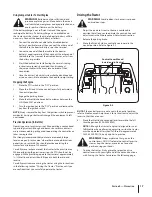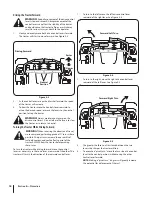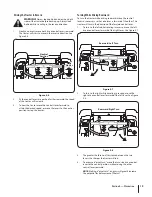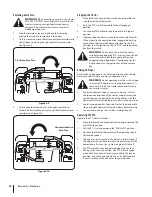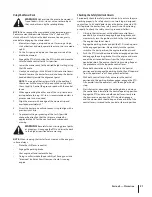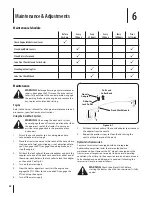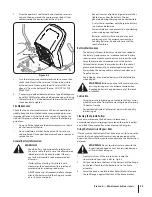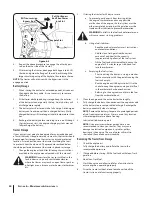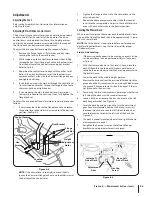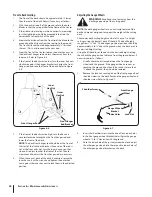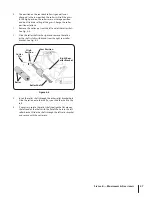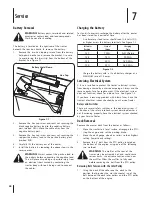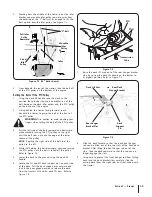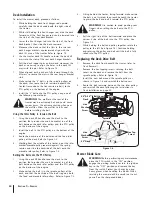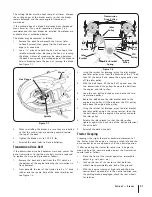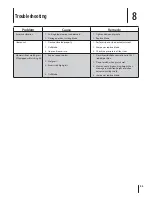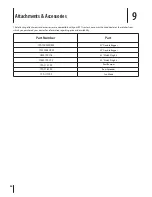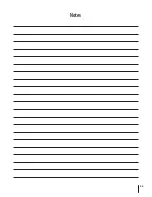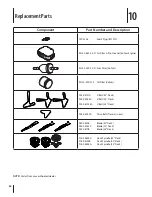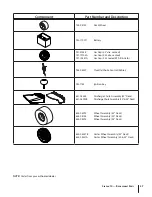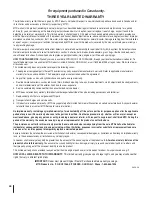
Pivot the operator’s seat forward and clean the reservoir
1.
cap and the area around the cap to prevent debris from
contaminating the transmission oil. See Fig. 6-2.
Turn the reservoir cap counterclockwise to re-move, then
2.
check the oil level in the reservoir. Oil should be visible
at the bottom of the cup, but the oil level must NOT be
above 1⁄4” from the bottom of the cup. DO NOT FILL THE
RESERVOIR.
If necessary to add oil because of some type of leakage, use
3.
a quality 20W50 motor oil and add only enough oil to bring
the level within 1⁄4” of the bottom of the reservoir. Reinstall
the cap and fully tighten.
Tire Maintenance
Check the tire air pressure after every 50 hours of operation or
weekly. Keep the tires inflated to the recommended pressures.
Improper inflation will shorten the tire service life. See the tire
side wall for proper inflation pressures. Observe the following
guidelines:
Do not inflate a tire above the maximum pressure shown
t
on the sidewall of the tire.
Do not reinflate a tire that has been run flat or seriously
t
under inflated. Have a qualified tire mechanic inspect and
service the tire.
General Battery Information
8"3/*/(
Should battery acid accidentally splatter into
t
the eyes or onto the skin, rinse the affected area
immediately with clean cold water. If there is
any further discomfort, seek prompt medical
attention.
If acid spills on clothing, first dilute it with
t
clean water, then neutralize with a solution of
ammonia/water or baking soda/water.
NEVER connect (or disconnect) battery charger
t
clips to the battery while the charger is turned
on, as it can cause sparks.
Keep all sources of ignition (cigarettes, matches,
t
lighters) away from the battery. The gas
generated during charging can be combustible.
As a further precaution, only charge the battery
t
in a well ventilated area.
Always shield eyes and protect skin and clothing
t
when working near batteries.
Batteries contain sulfuric acid and may emit
t
explosive gases. Use extreme caution when
handling batteries. Keep batteries out of the
reach of children.
Battery Maintenance
The battery is filled with battery acid and then sealed at
t
the factory. However, even a “maintenance free” battery
requires some maintenance to ensure its proper life cycle.
Spray the terminals and exposed wire with a battery
t
terminal sealer, or coat the terminals with a thin coat of
grease or petroleum jelly, to protect against corrosion.
Always keep the battery cables and terminals clean and
t
free of corrosion.
Avoid tipping. Even a sealed battery will leak electrolyte
t
when tipped.
8"3/*/(
Batteries contain sulfuric acid and may
emit explosive gases. Use extreme caution when
handling batteries. Keep batteries out of the reach
of children.
Lubrication
Using a pressure lubricating gun, lubricate the front castor
t
wheel axles and the front pivot axle with grease after every
10 hours of service.
Periodically lubricate all other pivot points with a quality
t
lubricating oil.
Cleaning the Spindle Pulleys
Once a month remove the belt covers to remove any
accumulation of grass clippings from around the spindle pulleys
and V-belt. Clean more often when mowing tall, dry grass.
Using the Transmission Bypass Rods
If for any reason the tractor will not drive or you wish to move the
tractor, the two hydrostatic transmissions are equipped with a
bypass rod that will allow you to manually move the tractor short
distances.
8"3/*/(
Do not tow the tractor, even with the
bypass rod engaged. Serious transmission damage
will result from doing so.
From just in front of the two rear tires, locate the
1.
transmission bypass rods. Refer to Fig. 6-3.
Pull one rod toward the front of the tractor until the flange
2.
on the rod is forward of the keyhole slot in the frame
assembly.
Lower the bypass rod into the keyhole slot and release so
3.
the rod flange is against the front of the frame bracket.
3FTFSWPJS$BQ
'JHVSF
23
S
ECTION
6 — M
AINTENANCE
& A
DJUSTMENTS
Summary of Contents for ZT50
Page 35: ...Notes ...









